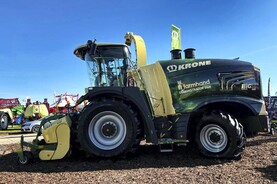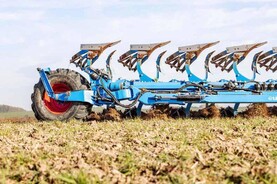Combined Powers is the name of a joint project between Lemken and Krone and it involves a diesel-electric autonomous tractor design concept.
Using a diesel-electric drive that generates up to 230hp (170kW), the manufacturers say the drive unit is designed to meet the power requirements of the implements used in processes such as cultivating, ploughing, sowing, mowing, tedding and raking.
The companies say the drive power is transferred electrically to the wheels and the PTO, and from there to the implement which couples to a three-point linkage.
The drive unit boasts multiple sensor systems which monitor the immediate surroundings and the implement attached, with safe operation and optimum results as the primary objectives.

Combined Powers is the name of the joint project between Lemken and Krone and it involves a diesel-electric autonomous tractor design concept.
The operators can control and monitor the combination from a mobile device, transmitting jobs and job reports via a communication module and the agrirouter, the established data exchange hub.
Controlled by the implement
The manufacturers say that the speciality of the process unit is that it is controlled by the implement and not vice versa. The implement and the drive unit act as one integrated smart system.
Based on the long experience of using IsoBus and TIM on Krone and Lemken machines, the drive unit and implement communicate and interact, sharing all types of data.

Using a diesel-electric drive that generates up to 230hp (170kW), the manufacturers say the drive unit is designed to meet the power requirements of the implements used in processes such as cultivating, ploughing, sowing, mowing, tedding and raking.
The ‘Combined Powers’ design concept was also developed to counter the increasing shortage of skilled labour in agriculture, while reducing the length of time farmers spend in the field. The companies say that instead, farmers will become system operators who merely monitor the process unit which delivers a consistent, accurate quality of work.
They concluded by saying the unit is designed for year-round work and a long service life, with further trialling in all types of conditions set to continue this year.
Combined Powers is the name of a joint project between Lemken and Krone and it involves a diesel-electric autonomous tractor design concept.
Using a diesel-electric drive that generates up to 230hp (170kW), the manufacturers say the drive unit is designed to meet the power requirements of the implements used in processes such as cultivating, ploughing, sowing, mowing, tedding and raking.
The companies say the drive power is transferred electrically to the wheels and the PTO, and from there to the implement which couples to a three-point linkage.
The drive unit boasts multiple sensor systems which monitor the immediate surroundings and the implement attached, with safe operation and optimum results as the primary objectives.

Combined Powers is the name of the joint project between Lemken and Krone and it involves a diesel-electric autonomous tractor design concept.
The operators can control and monitor the combination from a mobile device, transmitting jobs and job reports via a communication module and the agrirouter, the established data exchange hub.
Controlled by the implement
The manufacturers say that the speciality of the process unit is that it is controlled by the implement and not vice versa. The implement and the drive unit act as one integrated smart system.
Based on the long experience of using IsoBus and TIM on Krone and Lemken machines, the drive unit and implement communicate and interact, sharing all types of data.

Using a diesel-electric drive that generates up to 230hp (170kW), the manufacturers say the drive unit is designed to meet the power requirements of the implements used in processes such as cultivating, ploughing, sowing, mowing, tedding and raking.
The ‘Combined Powers’ design concept was also developed to counter the increasing shortage of skilled labour in agriculture, while reducing the length of time farmers spend in the field. The companies say that instead, farmers will become system operators who merely monitor the process unit which delivers a consistent, accurate quality of work.
They concluded by saying the unit is designed for year-round work and a long service life, with further trialling in all types of conditions set to continue this year.








 This is a subscriber-only article
This is a subscriber-only article










SHARING OPTIONS: